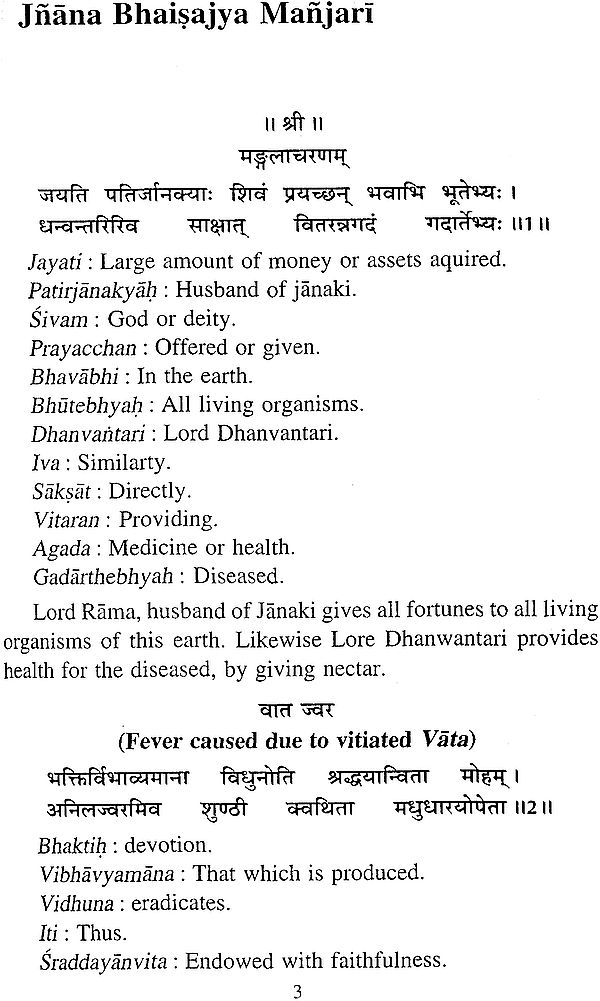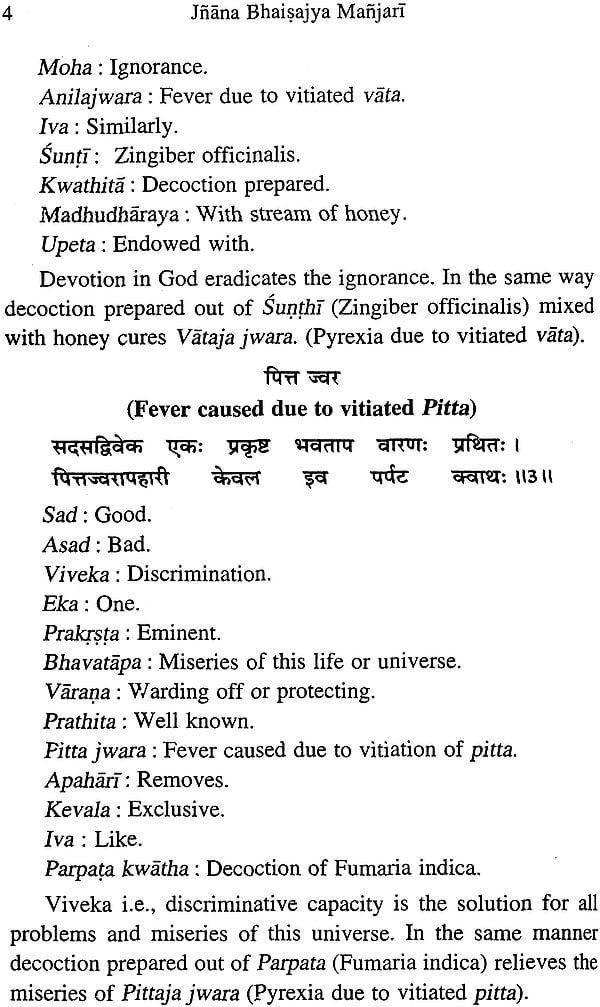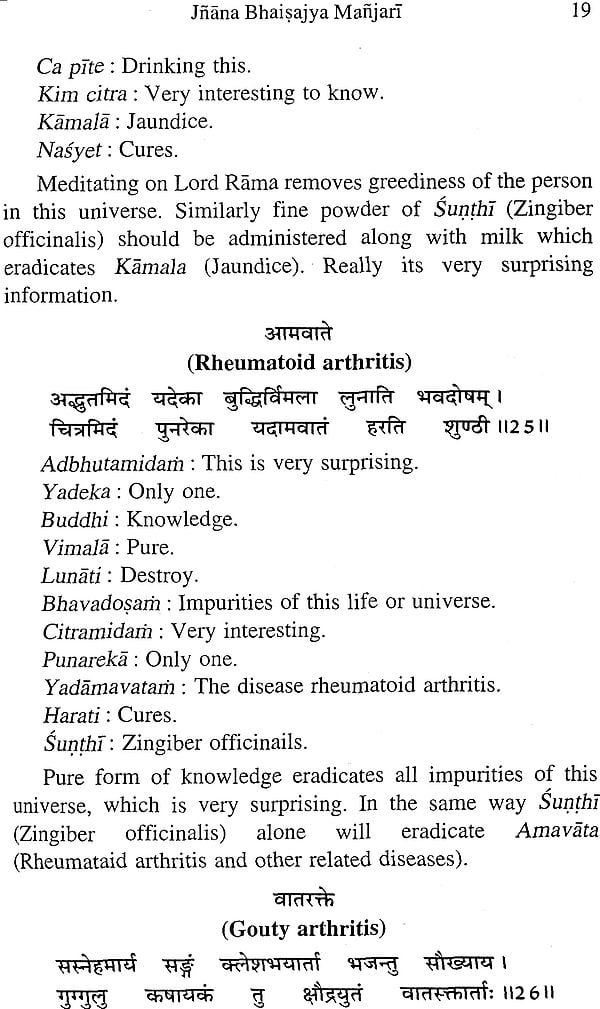
Jnana Bhaisajya Manjari (A Text on Philosophical Therapeutics)
Book Specification
| Item Code: | NAN412 |
| Author: | Dr. Arhanth Kumar A and Dr. Shreevathsa |
| Publisher: | Chaukhambha Visvabharati |
| Language: | Sanskrit Text With Word-to-Word Meaning English Translation |
| Edition: | 2016 |
| ISBN: | 9789381301814 |
| Pages: | 78 |
| Cover: | Paperback |
| Other Details | 8.5 inch x 5.5 inch |
| Weight | 110 gm |
Book Description
‘Jnana Bhaisajya Manjari’ is an unique text written by Shri Pandith Dattarama. He was the son of Mathura Krsna Lala. Was belonging to the city Mathura. As state by the author, the text was written in Vikramabdi 1952 and Sake 1818.
The text contains 82 slokas (verses). In the first verse author solutes his diety viz Lord Rama, Lord Siva and Lord Dhanwantari. In the last verse, the author says about the importance of the text. The starting colophon is ‘Shri Nikunja Viharine Namah’ i.e., I solute to, who is residing in a pleasant shady under trees.
In the ending colophon author gave his identification.
‘Lord Rama’ see to be the diety worshipped by Author. He stated Lord Rama throughout the text. Its representing the belief of the author and glory of the epic Ramayana. ‘Jnanabhaisajya Manjari’ is published Khemaraja Shri Krishnadasa Publication, Mumbai.
Its an unique text which narrated simple remedy for every disease with a life lesson also. Thus both aims of Ayurveda i.e.,Swasthya Raksana (Maintanace and promotion of health) and Vikara prasamana (Eradication of diseases) are achieved in this text.
Wise celestial lords, who have acquired wisdom from all the canons, have praised Lord Adinatha with hymns bringing joy to the audience of three realms (Heaven, earth and hell). I shall be stead fast in my endeavour to praise that first Tirthankara.
I bow my head to the supreme power Lord Santinatha and Bhagavan Bahubali for giving me the gread .oppurtunity to translate the treatise ‘Jnana Bhaisajya Manjari’ in to english.
At the same time, my respectful salutation to 108 Aryika Kundusri Mataji, Late 105 Ksullak Padmasri Mataji, 108 Munisri Mahimasagarji Maharaj and Dharmadhikari Rajarsi Dr. D. Veerendra Heggade Ji for their divine blessing and concern on me and my family.
Words are never sufficient to express my deepest gratitude and salutations to my parents Mr. Chandrasnekhar A. and Smt. Nagarathna A. for for being with me in all good and bad moments of my life. They were being my role models and supporting and caring me. Without them this work would not happen.
I express my deepest gratitude and thanks to my life partner Smt. Nandashree for being with me in all critical situations and supporting me and my career. Without her encouragement and assistance this would't be completed and successful.
I desire to express my deep gratitude and love to my brother Mr. Vijay Kumar A., Sister Mrs. Rashmi A., Sister in law Mrs.
Navarathna H.P., Brother in law Dr. Arun Jainer, nephew Prashan and Avichal, my uncloe Mr. Mitrasen Jain and Satyendra Kumar and and my relatives and well wishing friends for their continuous support, without them this work wouldn’t have reached this level.
Salutations to that respected teacher who showed the pIace of the one who pervades the vast universe with all its move and immovable things.
I bestow my deep and adorable bowing to one Such resepectable teacher Dr. Shreevathsa, who showed me the length and breadth of the knowledge of Ancient Indian Medical Heritage i.e. Ayurveda. Words are not enough to express thanks to him for his continuous care, concern and support in all professional and personal achievements.
As far as possible all factors should be analysed discussed. explained in their entirety. After obtaining thorough knowledge one should involve in action. ‘Jnana and Bhaisajya’ are mandatory for the maintanance of Ayu (Life spce). For attainment of Dhatunsamya (Homeostasis of human component) also in case of Vyadhi (Disease),both Jnana (Real knowledge about disease and diseased) and Bhaisajya (Therapies) are essential. The opportunity to work on 'Jnana Bhaisajya Manjari’ is the blessing in our life.
It gives me an immense pleasure to share this unique work on Ayurveda therapeutics with fraternity of Ayurveda.
I thank god 'The Supreme Almighty' for making this work success and for giving big thing and small in my life.
Its my duty to express my gratitude towards all my teachers best friends, well wishers, students and patients who made my journey of life more colourful I. They taught me the lessons of life.
I salute my father Shri B.S. Manjunath and mother Smt. Bharati whose persistant support, care, encouragement and timely guidence made my life more meaningful.
Its my duty and responsibility to thank my life partner Dr. Nagashree who helped and adviced me regarding various technical aspects of the text. My daughter Bhamati who made my life more joyfull must be acknowledged here.
God blesses with certain gifts and relations in life. Dr. Arhanth Kumar A. is such gift in my life. Words are not sufficient to thank the co-author of this text Dr. Arhanth Kumar A. who helped me for the completion of the work. He gave many inputs and informations regarding different technical aspects. He stood behind me through andthe work of this book.
I thank each and every person who helped directly or indirectly for the successful completion of the work, translation of.
Jnana Bhaisajya Manjari
'Jnana Bhaisajya Manjari' is an unique text written by Shri Pandith Dattarama. He was the son of Mathura Krsna Lala. He was belonging to the city Mathura. As state by the author, the text was written in Vikramabdi 1952 and Sake 1818.
The text contains 82 slokas (verses). In the first verse author solutes his diety viz Lord Rama, Lord Siva and Lord Dhanwantari. In the last verse, the author says about the importance of the text. The starting colophon is 'Shri Nikunja Viharine Namah’ i.e., I solute to, who is residing in a pleasant shady place under trees.
In the ending colophon author gave his identification.
'Lord Rama' seem to be the diety worshipped by Author. He stated Lord Rama throughout the text. Its representing the belief of the author and glory of the epic Ramayana. ‘Jnanabhaisajya Manjari' is published by Khemaraja Shri Krishnadasa Publication, Mumbai.
Its an unique text which narrated simple remedy for every disease with a life lesson also. Thus both aims of Ayurveda i.e., Swasthya Raksana (Maintanance and promotion of health) and Vikara prasamana (Eradication of diseases) are achieved in this text.
An eye opener for Philosophical Therapeutics
The text narrates single drug/single formulation/single therapy for the management of particular disease along with one simile stating good conduct needed for the mankind.
The text is giving more value for the social harmony by stating one good conduct in each verse.
Formulations stated here are Kwatha (Decoction), Curna (Powder), Swarasa (Juice), Taila (Medicated oil), Lepa (Application of medicines dermally), Anjana (Collyrium), Usna jala (Systematicaly bolied water), Ghrta (Medicated ghee), Bhasma (Ash prepared therapeutically).
The Rasa dravyas mentioned in this text are: Saindhava (Rocksalt), Gandhaka (SuIpur), Tankana (Borax), Yavaksara (Mixture of pottassium salts), Gairika (Orchre), Tuttha (Blue vitriol), Samudra phena (Cuttle fish bone), Haratala (Orpiment), Manahsila (Realgar) and Sankha (Conch shell).
The purificatory procedures mentioned here are Vamana (Therapeutic emesis), Virecana (Therapeutic purgation) and Nasya (Errhine therapy), Dhumapana (Therapeutic smoking).
The formulations/drug/drugs mentioned in the text are simple, cost effective and easily avaible.
All Therapies are practically applicable.
Points of good conduct explained in present text are applicable till today and certainly effective for self progress as well as the prosperity of the society.
Diseases of Astangas of Ayurveda (8 branches of Ayurveda) are mentioned along with treatment.
Spiritual procedures like worshiping, praying, offering and so on are mentioned throughout.
The author fulfills not only medical responsibilities but also social responsibilities.
Common Anupiinas (Vehicles) like Madhu (Honey), Ghrta (Ghee), Usna jala (Hot water), Ksira (Milk) and Guda (Jaggery) are mentioned in the text.
Its very surprising point in the text that all non-controversial, non-ambiguious herbs are mentioned.
Commonly occuring clinical conditions are dealt with. Yoga practices viz both Bahiranga yoga and Antaranga yoga are stated in various contexts.
Keen observation of the text reveals that it has influence from Samhitas till with the recent texts of Ayurveda like Yogaratnakara, Bhaisayaratnavali and so on.
Jangama dravyas stated in the text are cow's milk, foamy portion of cow's milk, butter milk, Honey, Ghee, Curd of Buffalo, Musk (Kasturi), Ear wax (Srotr mala), Sambuka mamsa (Snail/small conch shell), Akhu purisa (Faeces of mouse) and Haya lala (Saliva of horse).
Unique therapeutic formulation Buddha parada (Mercury Which is stabilized) is mentioned in the text.
| Mangalacaranam | 3 | |
| 2 | Vata jwara (Fever caused due to Vata) | 3 |
| 3 | Pitta jwara (Fever caused due to vitiated Pitta) | 4 |
| 4 | Kapha jwara (Fever caused due to vitiated Kapha) | 5 |
| 5 | Triosa jwara (Fever caused due to vitiatiation of all three Dosas) | 5 |
| 6 | Visama jwara (Irregular fever) | 6 |
| 7 | Jirna jwara (Chronic fever) | 7 |
| 8 | Atisars (Diarrhoea) | 7 |
| 9 | Arsa roga (Haemorrhoids) | 8 |
| 10 | Sangranyam (Sprue disease) | 9 |
| 11 | Ajirna (Indigestion) | 10 |
| 12 | Krmiroga (Microbic disorders) | 10 |
| 13 | Antardaha (Interbal burning sensation) | 11 |
| 14 | Raktapitta (Bleeding disorders) | 11 |
| 15 | Ksaya (Koch;s disease) | 12 |
| 16 | Nasarudhira sruta (Nasal bleeding) | 13 |
| 17 | Kasaroga (Cough) | 14 |
| 18 | Chikka (Hiccup) | 14 |
| 19 | Swasa roga (Dyspnoea) | 15 |
| 20 | Svarabheda (Hoarseness of voice) | 16 |
| 21 | Aruci (Loss of appetite) | 16 |
| 22 | Chardiroga (Vomiting) | 17 |
| 23 | Apasmara (Epilepsy) | 18 |
| 24 | Kamala roga (Jaundice) | 18 |
| 25 | Amavata (Rheumatoid arthritis) | 19 |
| 26 | Vatarakta (Gouty arthritis) | 19 |
| 27 | Sula roga (Pain abdomen) | 20 |
| 28 | Udavarta (Upward movement of vata?) | 21 |
| 29 | Mutrakrcchra (Dysurea) | 22 |
| 30 | Prameha (Diabetes mellitus) | 22 |
| 31 | Sotha (Edema) | 23 |
| 32 | Vrana roga (Wound) | 24 |
| 33 | Amlapitta (Gastritis) | 24 |
| 34 | Upadamsa (Soft chancre) | 25 |
| 35 | Kusta roga (Leprosy) | 26 |
| 36 | Kunakha (Whitlow) | 26 |
| 37 | Tarunya pitaka (Acne vulgaris) | 27 |
| 38 | Vipadika (Foot crack) | 28 |
| 39 | Indralupta (Alopecia) | 28 |
| 40 | Arumsika (Seborrhic dermatitis) | 29 |
| 41 | Kanduroga (Itch) | 30 |
| 42 | Carmakila (Wart) | 31 |
| 43 | Mastaka roga (Head diseases) | 31 |
| 44 | Suryavartarddhabheda (Migraine) | 32 |
| 45 | Netra roga (Eye disorders) | 33 |
| 46 | Naktandhya (Night blindness) | 34 |
| 47 | Netrapuspa (Blurred vision) | 34 |
| 48 | Badhirya (Deafness) | 35 |
| 49 | Karna roga (Ear disorders) | 36 |
| 50 | Karna srava (Otorrhoea) | 36 |
| 51 | Nasika roga (Nasal disorders) | 37 |
| 52 | Pinasa (Rhinitis) | 38 |
| 53 | Osta roga (Lip diseases) | 39 |
| 54 | Danta roga (Tooth diseases) | 39 |
| 55 | Mukhapaka (Stomatitis) | 40 |
| 56 | Pradara roga (Menorrhegia) | 41 |
| 57 | Garbha srava (Abortion) | 41 |
| 58 | Prasuti (Parturating woman) | 42 |
| 59 | Stanya roga (Breast diseases) | 43 |
| 60 | Balasya aruci (Loss of taste in children) | 43 |
| 61 | Balaroga (Paediatric diseases) | 44 |
| 62 | Citrakusta (Leucoderma) | 45 |
| 63 | Palita roga (Gray hairs) | 46 |
| 64 | Vajikarana (Aphrosidiac) | 46 |
| 65 | Sukrastambhana (Ejaculation stabilization) | 47 |
| 66 | Stri vasikarana (Controlling woman) | 48 |
| 67 | Linga vrddhi (Phallus size increasing preparation) | 49 |
| 68 | Vandhya roga (Infertility) | 49 |
| 69 | Garbha nivarana (Contraceptive) | 50 |
| 70 | Bhaga sankoca (Vaginal contraction) | 51 |
| 71 | Stana vrddhi (Breast size increaser) | 52 |
| 72 | Anidra (Insomnia) | 52 |
| 73 | Atinidra (Excessive sleep) | 53 |
| 74 | Romanutpatti (Hair growth enhancer) | 54 |
| 75 | Romanasana (Hair remover) | 54 |
| 76 | Kesa vrddhi (Hair growth enhancer) | 55 |
| 77 | Sarpa visa (Snake poison) | 56 |
| 78 | Vrscika visa (Scorpion poison) | 56 |
| 79 | Sthavara jangama visa (Static and mobile poison) | 57 |
| 80 | Visasya made (Poison and alcoholic intoxication) | 58 |
| 81 | Granthakartuh prarthana | 59 |
| Bibliography | 60 | |
| Appendix - I: Posology | 61 | |
| Appendix - II: Ayurvedic pharmaceutics | 63 | |











